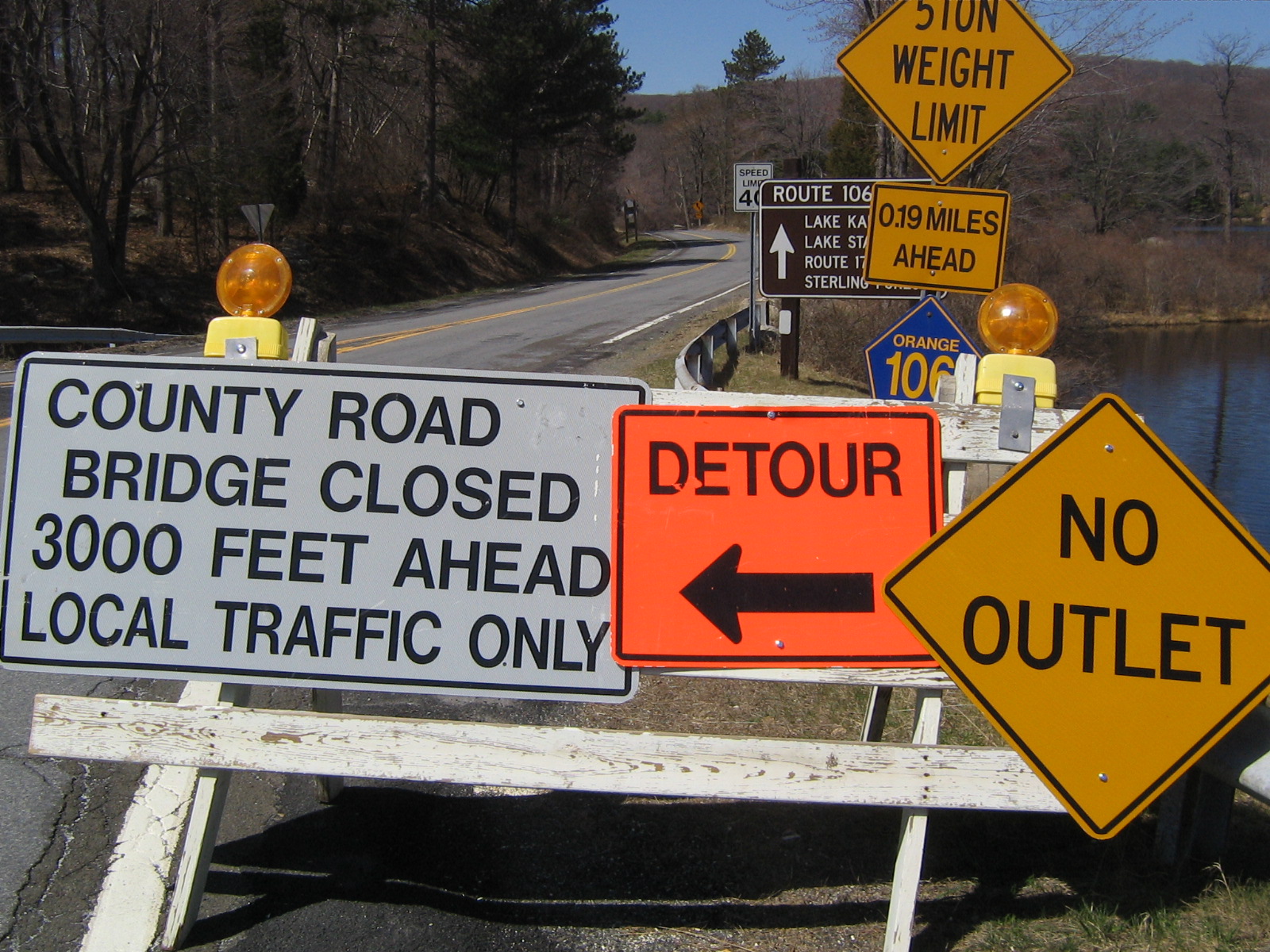|
SmartFIX40
SmartFIX40 was a major transportation improvement project coordinated by the Tennessee Department of Transportation (TDOT) along Interstate 40 (I-40) in downtown Knoxville, Tennessee. The project, referred to as the most ambitious TDOT project at the time, consisted of two separate phases and contracts, started construction in 2005 and was completed in June 2009 at a cost of $190 million. The second phase of the project required the closure of 1.5 miles of I-40 in downtown for a 14-month period, rerouting traffic onto the Interstate 640 (I-640) northern bypass of downtown. At the time of its completion, SmartFIX40 was the largest awarded contract and construction project in Tennessee history, and in retrospective documentation has received acclaim for its methods of accelerated construction and project delivery, including nationwide awards from the American Association of State Highway and Transportation Officials (AASHTO). Background The current freeway system in Knoxville ... [...More Info...] [...Related Items...] OR: [Wikipedia] [Google] [Baidu] |
Interstate 40 In Tennessee
Interstate 40 (I-40) is part of the Interstate Highway System that runs from Barstow, California, to Wilmington, North Carolina. The highway crosses Tennessee from west to east, from the Mississippi River at the Arkansas border to the Blue Ridge Mountains at the North Carolina border. At , the Tennessee segment of I-40 is the longest of the eight states through which it passes and the state's longest Interstate Highway. I-40 passes through Tennessee's three largest cities— Memphis, Nashville, and Knoxville—and serves the Great Smoky Mountains National Park, the most-visited national park in the United States. It crosses all of Tennessee's physiographic regions and Grand Divisions—the Mississippi embayment and Gulf Coastal Plain in West Tennessee, the Highland Rim and Nashville Basin in Middle Tennessee, and the Cumberland Plateau, Cumberland Mountains, Ridge-and-Valley Appalachians, and Blue Ridge Mountains in East Tennessee. Landscapes on the route vary from fl ... [...More Info...] [...Related Items...] OR: [Wikipedia] [Google] [Baidu] |
Geometric Design Of Roads
The geometric design of roads is the branch of highway engineering concerned with the positioning of the physical elements of the roadway according to standards and constraints. The basic objectives in geometric design are to optimize efficiency and safety while minimizing cost and environmental damage. Geometric design also affects an emerging fifth objective called "livability", which is defined as designing roads to foster broader community goals, including providing access to employment, schools, businesses and residences, accommodate a range of travel modes such as walking, bicycling, transit, and automobiles, and minimizing fuel use, emissions and environmental damage. Geometric roadway design can be broken into three main parts: alignment, profile, and cross-section. Combined, they provide a three-dimensional layout for a roadway. * The alignment is the route of the road, defined as a series of horizontal tangents and curves. * The profile is the vertical aspect of th ... [...More Info...] [...Related Items...] OR: [Wikipedia] [Google] [Baidu] |
West Knoxville
West Knoxville is a section of Knoxville, Tennessee, US. It is west of the city's Downtown Knoxville, downtown area. It stretches from Sequoyah Hills, Tennessee, Sequoyah Hills on the east to the city's border with Farragut, Tennessee, Farragut on the west. West Knoxville is concentrated around Kingston Pike (U.S. Route 70 in Tennessee, US-70/U.S. Route 11, US-11), and along with Sequoyah Hills includes the neighborhoods of Lyons View, Forest Hills, Bearden (Knoxville, Tennessee), Bearden, West Hills (Knoxville, Tennessee), West Hills, Westmoreland Heights, Cedar Bluff, and Ebenezer.History of Kingston Pike/Sequoyah Hills 2008. Retrieved: 29 June 2011. "West Knoxville" originally referred to the area immediately west of Second Creek, i.e., what is now Fort Sanders (Knoxville neighborhood), Fort Sanders and t ... [...More Info...] [...Related Items...] OR: [Wikipedia] [Google] [Baidu] |
Joint Venture
A joint venture (JV) is a business entity created by two or more parties, generally characterized by shared ownership, shared returns and risks, and shared governance. Companies typically pursue joint ventures for one of four reasons: to access a new market, particularly emerging market; to gain scale efficiencies by combining assets and operations; to share risk for major investments or projects; or to access skills and capabilities.' Most joint ventures are incorporated, although some, as in the oil and gas industry, are "unincorporated" joint ventures that mimic a corporate entity. With individuals, when two or more persons come together to form a temporary partnership for the purpose of carrying out a particular project, such partnership can also be called a joint venture where the parties are "''co-venturers''". A joint venture can take the form of a business. It can also take the form of a project or asset JV, created for the purpose of pursuing one specific project, ... [...More Info...] [...Related Items...] OR: [Wikipedia] [Google] [Baidu] |
United States Congress
The United States Congress is the legislature, legislative branch of the federal government of the United States. It is a Bicameralism, bicameral legislature, including a Lower house, lower body, the United States House of Representatives, U.S. House of Representatives, and an Upper house, upper body, the United States Senate, U.S. Senate. They both meet in the United States Capitol in Washington, D.C. Members of Congress are chosen through direct election, though vacancies in the Senate may be filled by a Governor (United States), governor's appointment. Congress has a total of 535 voting members, a figure which includes 100 United States senators, senators and 435 List of current members of the United States House of Representatives, representatives; the House of Representatives has 6 additional Non-voting members of the United States House of Representatives, non-voting members. The vice president of the United States, as President of the Senate, has a vote in the Senate ... [...More Info...] [...Related Items...] OR: [Wikipedia] [Google] [Baidu] |
Federal Highway Administration
The Federal Highway Administration (FHWA) is a division of the United States Department of Transportation that specializes in highway transportation. The agency's major activities are grouped into two programs, the Federal-aid Highway Program and the Federal Lands Highway Program. Its role had previously been performed by the Office of Road Inquiry, Office of Public Roads and the Bureau of Public Roads. History Background With the coming of the bicycle in the 1890s, interest grew regarding the improvement of streets and roads in America. The traditional method of putting the burden on maintaining roads on local landowners was increasingly inadequate. In 1893, the federal Office of Road Inquiry (ORI) was founded; in 1905, it was renamed the Office of Public Roads (OPR) and made a division of the United States Department of Agriculture. Demands grew for local and state government to take charge. With the coming of the automobile, urgent efforts were made to upgrade and moderniz ... [...More Info...] [...Related Items...] OR: [Wikipedia] [Google] [Baidu] |
Detour
__NOTOC__ A detour or (British English: diversion) is a (normally temporary) route taking traffic around an area of prohibited or reduced access, such as a construction site. Standard operating procedure for many roads departments is to route any detour over roads within the same jurisdiction as the road with the obstructed area. On multi-lane highways (e.g., freeways, Limited-access road, expressways, city streets, etc.), usually contraflow lane reversal#Highway reconstruction, traffic shifts can replace a detour, as detours often congest turn lanes. Types Depending on the roadway affected, and the scope of construction, different types of detours may be used. The most basic is to simply close a stretch of roadway for a defined period of time, diverting all traffic around the site. Other types of detours may also be used, such as a detour that is only in effect at night, only in effect during weekends, or a detour that restricts through traffic while permitting local traffi ... [...More Info...] [...Related Items...] OR: [Wikipedia] [Google] [Baidu] |
Intelligent Transportation System
An intelligent transportation system (ITS) is an advanced application that aims to provide services relating to different modes of transport and traffic management and enable users to be better informed and make safer, more coordinated, and 'smarter' use of transport networks. Some of these technologies include calling for emergency services when an accident occurs, using cameras to enforce traffic laws or signs that mark speed limit changes depending on conditions. Although ITS may refer to all modes of transport, the directive of the European Union 2010/40/EU, made on July 7, 2010, defined ITS as systems in which information and communication technologies are applied in the field of road transport, including infrastructure, vehicles and users, and in traffic management and mobility management, as well as for interfaces with other modes of transport. ITS may be used to improve the efficiency and safety of transport in many situations, i.e. road transport, traffic management, ... [...More Info...] [...Related Items...] OR: [Wikipedia] [Google] [Baidu] |
Geotechnical Engineering
Geotechnical engineering, also known as geotechnics, is the branch of civil engineering concerned with the engineering behavior of earth materials. It uses the principles of soil mechanics and rock mechanics to solve its engineering problems. It also relies on knowledge of geology, hydrology, geophysics, and other related sciences. Geotechnical engineering has applications in military engineering, mining engineering, petroleum engineering, coastal engineering, and offshore construction. The fields of geotechnical engineering and engineering geology have overlapping knowledge areas. However, while geotechnical engineering is a specialty of civil engineering, engineering geology is a specialty of geology. History Humans have historically used soil as a material for flood control, irrigation purposes, burial sites, building foundations, and construction materials for buildings. Dykes, dams, and canals dating back to at least 2000 BCE—found in parts of ancient Egypt, ancient Mes ... [...More Info...] [...Related Items...] OR: [Wikipedia] [Google] [Baidu] |
Transportation Engineering
Transportation engineering or transport engineering is the application of technology and scientific principles to the planning, functional design, operation and management of facilities for any mode of transportation to provide for the safe, efficient, rapid, comfortable, convenient, economical, and environmentally compatible movement of people and goods transport. Theory The planning aspects of transportation engineering relate to elements of urban planning, and involve technical forecasting decisions and political factors. Technical forecasting of passenger travel usually involves an urban transportation planning model, requiring the estimation of trip generation, trip distribution, mode choice, and route assignment. More sophisticated forecasting can include other aspects of traveler decisions, including auto ownership, trip chaining (the decision to link individual trips together in a tour) and the choice of residential or business location (known as land use forec ... [...More Info...] [...Related Items...] OR: [Wikipedia] [Google] [Baidu] |
Knoxville News Sentinel
The ''Knoxville News Sentinel'', also known as ''Knox News'', is a daily newspaper in Knoxville, Tennessee, United States, owned by the Gannett Company. History The newspaper was formed in 1926 from the merger of two competing newspapers: ''The Knoxville News'' and ''The Knoxville Sentinel''. John Trevis Hearn began publishing ''The Sentinel'' in December 1886, while ''The News'' was started in 1921 by Robert P. Scripps and Roy W. Howard. The two merged in 1926 under Scripps-Howard ownership, with the first edition of ''The Knoxville News-Sentinel'' appearing on November 22 of that year. The editor from 1921 to 1931, Edward J. Meeman, later was sent to Memphis to edit the since defunct '' Memphis Press-Scimitar''. In 1986, the ''News-Sentinel'' became a morning paper, with the other paper in Knoxville, the '' Knoxville Journal'', becoming an evening paper. The ''Journal'' ceased publication as a daily in 1991, when the joint operating agreement between the two papers exp ... [...More Info...] [...Related Items...] OR: [Wikipedia] [Google] [Baidu] |
Constructability
Constructability (or buildability) is a concept that denotes ease of construction. It can be central to project management techniques to review construction processes from start to finish during pre-construction phase. Buildability assessment is employed to identify obstacles before a project is actually built to reduce or prevent errors, delays, and cost overruns. CII defines constructability as “the optimal use of construction knowledge and experience in planning, design, procurement, and field operations to achieve overall project objectives”. The term "constructability" can also define the ease and efficiency with which structures can be built. The more constructible a structure is, the more economical it will be. Constructability is in part a reflection of the quality of the design documents; that is, if the design documents are difficult to understand and interpret, the project will be difficult to build. The term refers to: * the extent to which the design of the bui ... [...More Info...] [...Related Items...] OR: [Wikipedia] [Google] [Baidu] |






